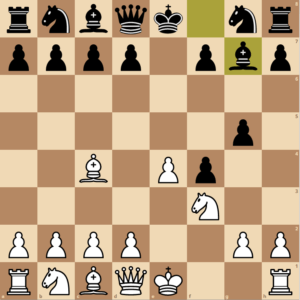The King’s Gambit is a King’s Pawn Opening beginning with 1. e4 e5 2. f4
The King’s Gambit is a King’s Pawn Opening beginning with 1. e4 e5 2. f4

White offers a pawn sacrifice on move two, with the aim of eliminating black’s central pawn. If black tries to hold on to the extra pawn, then white can develop rapidly and aim for a big attack on the enemy king!
The King’s Gambit is one of the oldest-known chess openings, bringing to mind the “Romantic Era” of chess. In these days, players were less concerned with pawn structure, planning, and positional play – chess was played with the sole aim of achieving an all-out attack on the opponent’s monarch!
Let’s consider black’s options against the King’s Gambit and see how the game might progress.
1. e4 e5 2. f4 exf4 3. Nf3 g5

This is perhaps black’s most ambitious way to handle the King’s Gambit. Black simply accepts the sacrificed pawn and reinforces it with …g5.
White plays Nf3 on move 3 to prevent black from playing …Qh4+, robbing the white king of its castling rights. Not only does the move …g5 lend support to black’s f4 pawn, but black might consider advancing with …g4 in some cases – kicking the white knight and renewing the threat of …Qh4+ !
One of the most exciting variations of the King’s Gambit continues 4. Bc4 g4 5. 0-0

Instead of moving the knight away and allowing …Qh4, white simply castles and lets black win a piece!
After 5…gxf3 6. Qxf3 we see the point – for the price of a piece, white has a big lead in development. All black pieces remain on their starting squares, and if white wins the f4-pawn back, white will have massive pressure against the f7 pawn.
Black can play 6…Qf6, preparing to exchange queens if white takes the f4 pawn. But white has no interest in this – exchanging queens would likely end his attack, and black would be heavily favored with his extra piece!
Instead 7. e5! Is the main move, sacrificing even more material to open the e-file. After 7…Qxe5 8. d3 Bh6 9. Nc3:

White is threatening to connect rooks by developing the dark bishop, followed by a pin on the e-file. An exciting game is sure to follow.

If black fears the Muzio, black may choose not to advance the pawn to g4 and to simply develop the bishop.
White will often try to undermine black’s pawn chain by playing h4 in the near future, but black often plays …h6 and tries to hold everything together. After 5. h4 h6 6. d4 d6 7. 0-0 Nc6 8. c3:

We arrive at a typical King’s Gambit position. Black remains up a pawn, but white has good central control. White might play Qb3 in the near future to increase the pressure on f7!
1. e4 e5 2. f4 exf4 3. Nf3 d5

In many openings where white gambits a pawn, it’s known that black can play …d5 to strike in the center – returning a pawn to speed up black’s development!
Here’s a sample line of how the game might progress: 4. exd5 Nf6 5. Bc4 Nxd5 6. 0-0 Be7 7. d4 0-0

White is able to win their pawn back with 8. Bxd5 Qxd5 9. Bxf4, but it will cost white the bishop pair. Nonetheless, white maintains a space advantage in the center for the time being, and the game is considered roughly equal.
1. e4 e5 2. f4 Bc5

This is black’s most popular way to declined the King’s Gambit, as it develops a piece actively. There’s no need to defend the e5 pawn right away – white can’t take it!
3. fxe5?? Qh4+ would be a disaster for white. After 4. g3 Qxe4+, white loses a rook.
A sample continuation might be 3. Nf3 d6 4. c3 Nf6 5. d4 exd4 6. cxd4 Bb6 7. Nc3 0-0

White succeeds in controlling the entire center with pawns, but black will have pressure on this center from afar. Black was able to castle far before white, and may play …Re8 next turn to increase the pressure on the center.
Before we conclude, let’s consider two other possibilities within the King’s Gambit – both of which I covered in the video above!
The King’s Gambit isn’t as popular now as it once was, but white’s attacking ideas remain as dangerous as ever – especially if black is unprepared for them!
If you’re willing to give up a pawn for the sake of an early attack, the King’s Gambit might be for you.
Thanks for reading! Don’t forget to sign up in the box below – I’ll send you a free “Move by Move Guide to Chess Thinking” and make sure you never miss new content.
Blake
Enter your email address to sign up for free!

